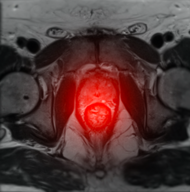Impeded Diffusion Fraction for Quantitative Imaging Diagnostic Assay
TECHNOLOGY NUMBER: 2021-130

OVERVIEW
A model and fit algorithm to improve MRI scanning in patients with cancer- Better differentiates water diffusion rates in vascular, ductal lumen, and cellular tissue
- May be utilized at the time of image acquisition or retroactively following scanning
BACKGROUND
Magnetic resonance imaging (MRI) is extensively used in cancer detection because of its ability to noninvasively capture detailed images of the body’s internal organs. One specific MRI technique used specifically for these purposes involves the calculation of the Apparent Diffusion Coefficient (ADC), which measures water molecule diffusion in tissues. The quantitative evaluation of water molecule diffusion is impacted by the cellular structure and organization of a tissue, with malignant lesions commonly more restrictive to water movement. Specifically, cancerous tumors have a higher ratio of cellularity to extracellular space, causing an increased epithelium volume that decreases the presence of stroma and limits lumen size. The resulting lower ADC value on MRI scans correlates with tissue microstructure and aids screening of cancer as well as the results of anti-neoplastic interventions. Still, ADC uses a simple two-point measurement and has been associated with unnecessary biopsies in a number of clinical studies. As such, a need exists for improved methods to utilize MRI scanning for screening and treatment response in patients with cancer.
INNOVATION
Researchers have created a model and fit algorithm that better optimizes the usefulness of MRI scanning in the setting of cancer staging in glandular tissues. The innovation more effectively quantitates impeded diffusion fraction (IDF) contribution from water coordinated by macromolecules to diffusion weighted image (DWI) voxel signals. The methodology takes into account fundamentally different water diffusion rates in vascular, ductal lumen, and cellular tissue compartments. This approach can be applied to develop quantitative imaging essays with objective thresholds for multiple types of cancers by utilization of common acquisition protocols. Additionally, the model may be utilized either at the time of image acquisition or respectively after the MRI has been completed. The ability to remove unwanted signal components from bound water are especially important for evaluating clinical data, which often faces more imaging noise. Additionally, the innovation may be used to evaluate any type of organ, given that its only hard assumption involves T-dependent diffusion of water.